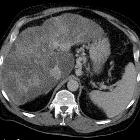contrast nephropathy
Contrast-induced nephropathy (CIN) describes an association between intravenous or intra-arterial contrast administration and renal impairment, but increasingly the evidence shows that contrast is not the cause of the renal impairment and that confounding factors such as sepsis are likely to be responsible.
A number of case-controlled studies and meta-analyzes have been published, with most identifying no difference in the incidence of renal impairment between patients receiving and not receiving intravenous contrast, in patients with baseline normal renal function. One of the major confounding factors of propensity-matched case-controlled studies is that even though baseline renal function may have been similar in the two groups, physicians may have chosen to not prescribe contrast to sicker patients, so the two cohorts may have in fact not been truly matched. There are no randomized controlled trials as yet.
Definition
A number of different definitions are used in the literature, most relying on measurement of serum creatinine concentrations. A baseline creatinine level should be obtained before the procedure. Estimated glomerular filtration rate (eGFR) has been used for the assessment of renal function before intravenous contrast injection. This is calculated from the patient's age, race, sex and serum creatinine level. Online calculators are also available to assist in easily calculating eGFR.
Post-contrast peak effect on creatinine occurs between 48 and 72 hours:
- relative: 50% rise over baseline
- absolute: increase of greater than 27 μmol/L
Contrast-induced acute kidney injury (CI-AKI) has also been described in which injury or damage to the kidney has taken place, but is subclinical in that no measurable reduction in renal filtration is apparent.
The American College of Radiology suggests using the term postcontrast acute kidney injury (PC-AKI) rather than CIN as the literature points to an association but not causality .
Risk stratification
Risk for most normal individuals with no risk factors is based on baseline renal function, using creatinine (Cr) or creatinine clearance (CrCl) as surrogate markers:
- low: Cr <130 μmol/L or CrCl >60 mL/min
- medium: Cr 130-200 μmol/L or CrCl 30-60 mL/min
- high: Cr >200 μmol/L or CrCl <30 mL/min
For risk stratification using eGFR:
- very low risk: >60 mL/min
- low risk: 45-59 mL/min
- moderate: 30-45 mL/min
- high risk: <30 mL/min
The Royal Australian and New Zealand College of Radiologists recommend that patients in the emergency setting that require contrast media for computed tomographic examinations should have no delay to scan time due to renal function testing .
The stance of the American College of Radiology in their Manual on Contrast is that “at the current time, there is very little evidence that IV iodinated contrast material is an independent risk factor for AKI in patients with eGFR ≥30 mL/min/1.73 m”
High dose contrast
However, if they are going to have an investigation with more than 300 mL of iodinated contrast or two studies less than 72 hours apart, their risk is elevated to the medium group irrespective of their baseline renal function.
Predisposing risk factors
Patients with risk factors are automatically elevated to higher risk groups
- diabetes mellitus, multiple myeloma, congestive heart failure, cirrhosis, nephrotic syndrome, sepsis
- low: as above
- medium: Cr 110-130 μmol/L or CrCl <90 mL/min
- high: Cr 130-200 μmol/L or CrCl <60 mL/min
- renal transplant, dehydration or hypotension
- low: not possible
- medium: even if their renal function is normal
- high: Cr 130-200 μmol/L or CrCl 30-60 mL/min
Treatment and prognosis
The most important factor is adequate prehydration and assessment of renal function. Risk stratification helps to determine what the most appropriate preparation is, and protocols will vary from institution to institution:
- low: oral fluids only
- medium:
- IV 0.9% normal saline for 12 hours before and after the procedure
- at 48 hours: if the creatinine is 25% above baseline, a further check five days post-procedure should be taken
- high:
- IV 0.9% normal saline for 12 hours before and after the procedure
- N-acetylcysteine (NAC) 600 mg orally bd (three days before the procedure and one day afterwards)
- check creatinine at baseline, 48 hours, five days and ten days
Siehe auch:
und weiter:

 Assoziationen und Differentialdiagnosen zu contrast nephropathy:
Assoziationen und Differentialdiagnosen zu contrast nephropathy:

